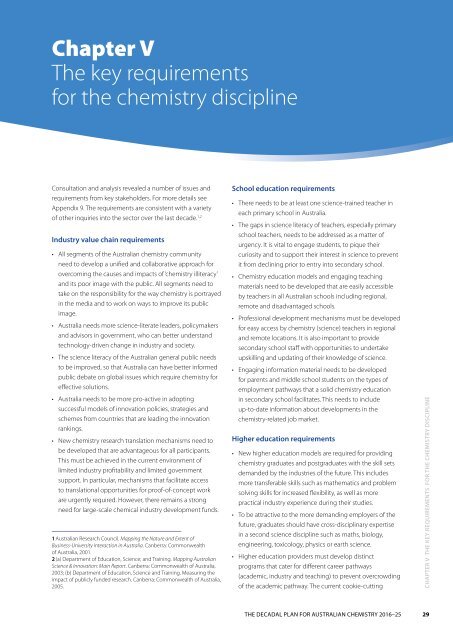Chemistry for a better life
1OiFLmD
1OiFLmD
You also want an ePaper? Increase the reach of your titles
YUMPU automatically turns print PDFs into web optimized ePapers that Google loves.
Chapter V<br />
The key requirements<br />
<strong>for</strong> the chemistry discipline<br />
Consultation and analysis revealed a number of issues and<br />
requirements from key stakeholders. For more details see<br />
Appendix 9. The requirements are consistent with a variety<br />
of other inquiries into the sector over the last decade. 1,2<br />
Industry value chain requirements<br />
• All segments of the Australian chemistry community<br />
need to develop a unified and collaborative approach <strong>for</strong><br />
overcoming the causes and impacts of ‘chemistry illiteracy’<br />
and its poor image with the public. All segments need to<br />
take on the responsibility <strong>for</strong> the way chemistry is portrayed<br />
in the media and to work on ways to improve its public<br />
image.<br />
• Australia needs more science-literate leaders, policymakers<br />
and advisors in government, who can <strong>better</strong> understand<br />
technology-driven change in industry and society.<br />
• The science literacy of the Australian general public needs<br />
to be improved, so that Australia can have <strong>better</strong> in<strong>for</strong>med<br />
public debate on global issues which require chemistry <strong>for</strong><br />
effective solutions.<br />
• Australia needs to be more pro-active in adopting<br />
successful models of innovation policies, strategies and<br />
schemes from countries that are leading the innovation<br />
rankings.<br />
• New chemistry research translation mechanisms need to<br />
be developed that are advantageous <strong>for</strong> all participants.<br />
This must be achieved in the current environment of<br />
limited industry profitability and limited government<br />
support. In particular, mechanisms that facilitate access<br />
to translational opportunities <strong>for</strong> proof-of-concept work<br />
are urgently required. However, there remains a strong<br />
need <strong>for</strong> large-scale chemical industry development funds.<br />
1 Australian Research Council. Mapping the Nature and Extent of<br />
Business-University Interaction in Australia. Canberra: Commonwealth<br />
of Australia, 2001.<br />
2 (a) Department of Education, Science; and Training. Mapping Australian<br />
Science & Innovation: Main Report. Canberra: Commonwealth of Australia,<br />
2003; (b) Department of Education, Science and Training. Measuring the<br />
impact of publicly funded research. Canberra: Commonwealth of Australia,<br />
2005.<br />
School education requirements<br />
• There needs to be at least one science-trained teacher in<br />
each primary school in Australia.<br />
• The gaps in science literacy of teachers, especially primary<br />
school teachers, needs to be addressed as a matter of<br />
urgency. It is vital to engage students, to pique their<br />
curiosity and to support their interest in science to prevent<br />
it from declining prior to entry into secondary school.<br />
• <strong>Chemistry</strong> education models and engaging teaching<br />
materials need to be developed that are easily accessible<br />
by teachers in all Australian schools including regional,<br />
remote and disadvantaged schools.<br />
• Professional development mechanisms must be developed<br />
<strong>for</strong> easy access by chemistry (science) teachers in regional<br />
and remote locations. It is also important to provide<br />
secondary school staff with opportunities to undertake<br />
upskilling and updating of their knowledge of science.<br />
• Engaging in<strong>for</strong>mation material needs to be developed<br />
<strong>for</strong> parents and middle school students on the types of<br />
employment pathways that a solid chemistry education<br />
in secondary school facilitates. This needs to include<br />
up-to-date in<strong>for</strong>mation about developments in the<br />
chemistry-related job market.<br />
Higher education requirements<br />
• New higher education models are required <strong>for</strong> providing<br />
chemistry graduates and postgraduates with the skill sets<br />
demanded by the industries of the future. This includes<br />
more transferable skills such as mathematics and problem<br />
solving skills <strong>for</strong> increased flexibility, as well as more<br />
practical industry experience during their studies.<br />
• To be attractive to the more demanding employers of the<br />
future, graduates should have cross-disciplinary expertise<br />
in a second science discipline such as maths, biology,<br />
engineering, toxicology, physics or earth science.<br />
• Higher education providers must develop distinct<br />
programs that cater <strong>for</strong> different career pathways<br />
(academic, industry and teaching) to prevent overcrowding<br />
of the academic pathway. The current cookie-cutting<br />
Chapter V The key requirements <strong>for</strong> the chemistry discipline<br />
THE DECADAL PLAN FOR AUSTRALIAN CHEMISTRY 2016–25 29


